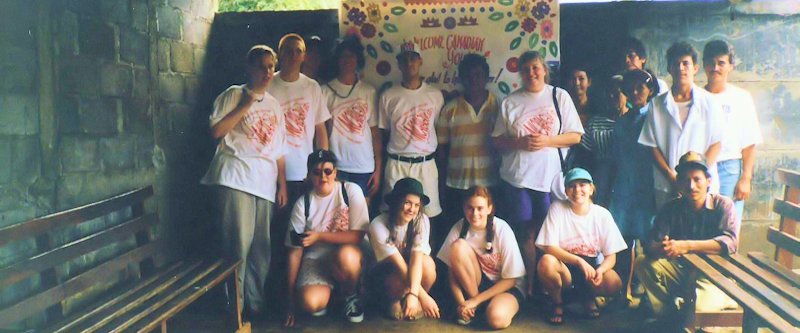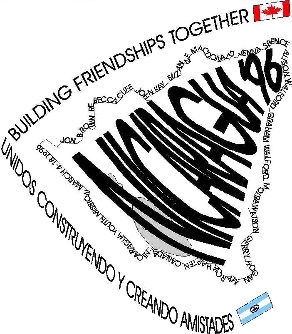
Some time in 1995 someone at Parkwood church got a brainwave: what a great idea it would be
if we could send a team to help John and Viola Duff with some of
their work in Nicaragua.
John Duff was a minister at Gloucester church, Ottawa, who had a heart for missions.
So much so that he and his wife Viola, a teacher of
nursing at the University of Ottawa,
signed up with the "Mission Board" (as it used to be called) and went to Nicaragua in 1994,
Viola to teach nursing at the
Politechnical University of Nicaragua (UPOLI), and John to do
mission work in a barrio of Managua, teaching English and doing "outreach" and otherwise
assisiting
the community in any way he could. The Duffs were known to our minister, Floyd
McPhee, and the work John and Vi were doing was encouraging. So maybe we could help
in some
way...
Well, to make a long introduction short, Parkwood sent a team of eight youth and two adults
to Managua in March 1996 to help John with his work in
the barrio. Mission: to build a
house in 2 weeks, a home for a family of 13+. Here is their story, as told by Gerry Hogan,
one of the adult leaders. Following
Gerry's account is an article by John Duff containing
some of his observations on the mission.
March 4, 1996, 7.30.am. 10 of us met at Mirabel airport. We called ourselves "The Nicaraguan
Youth Mission Team. our purpose was "To develop a better understanding
of the difference
between first and third world countries while working together alongside our fellow
Christian Nicaraguans." This we accomplished.
My fellow team members Marcia Harten (leader), Alison Walford, Graham Walford, Rebecca Cuff,  John Kay,
Parkwood Presbyterian Church, Jenna Spence and Suzanne McDonald, Grace Presbyterian
Church, Moira Watson, Fitzroy Harbour, Anglican and Jonathan Brown, United Church,
Russell.
Little did we really understand what to expect. Our plane was 3 1/2 hours late in take off.
I must admit I found this annoying and somewhat tiring. I was
soon to find out everything
in Nicaragua has a time of its own. Nobody is on time, neither do they have any conception
of keeping to a reasonable time schedule.
Things just get done sometime. Hard for us
Canadians to adjust to. We arrived safely and are met by a great team of guys from Upoli
University. Our host John Duff
and several from his department of Theology and Pastoral.
We were taken through the streets of Managua to our accommodation. My first observation
was that this city
was extremely poor, dirty, unkempt and very hot. Our hostel was very
basic. We occupied a Casa which held 11 people, 3 bedrooms with bunk beds, a bathroom and
a
sitting room. No air-conditioning and small fans that just shifted around the hot air.
We were surrounded by a high fence that had locked gates and was supervised
by a guard 24
hours a day. Believe me far from the safe secure feeling of our Canada. However this was
to become our home and we adjusted well to the routine at
Provadenic. The couple who managed
it, Carlos and Miriam were helpful. Miriam made excellent meals and served them up in our
friendly dining room. The food was
different. Rice and beans with every meal. I can
remember having eggs and bacon for breakfast, accompanied by rice and beans. The food
was interesting and
always a good variety. Salads were scarce. The fruit juices were
all homemade and out of this world, delicious. Nicaragua is heavy into "gasiosis" (pop).
It is
served a great deal. We also enjoyed bottled water.
John Kay,
Parkwood Presbyterian Church, Jenna Spence and Suzanne McDonald, Grace Presbyterian
Church, Moira Watson, Fitzroy Harbour, Anglican and Jonathan Brown, United Church,
Russell.
Little did we really understand what to expect. Our plane was 3 1/2 hours late in take off.
I must admit I found this annoying and somewhat tiring. I was
soon to find out everything
in Nicaragua has a time of its own. Nobody is on time, neither do they have any conception
of keeping to a reasonable time schedule.
Things just get done sometime. Hard for us
Canadians to adjust to. We arrived safely and are met by a great team of guys from Upoli
University. Our host John Duff
and several from his department of Theology and Pastoral.
We were taken through the streets of Managua to our accommodation. My first observation
was that this city
was extremely poor, dirty, unkempt and very hot. Our hostel was very
basic. We occupied a Casa which held 11 people, 3 bedrooms with bunk beds, a bathroom and
a
sitting room. No air-conditioning and small fans that just shifted around the hot air.
We were surrounded by a high fence that had locked gates and was supervised
by a guard 24
hours a day. Believe me far from the safe secure feeling of our Canada. However this was
to become our home and we adjusted well to the routine at
Provadenic. The couple who managed
it, Carlos and Miriam were helpful. Miriam made excellent meals and served them up in our
friendly dining room. The food was
different. Rice and beans with every meal. I can
remember having eggs and bacon for breakfast, accompanied by rice and beans. The food
was interesting and
always a good variety. Salads were scarce. The fruit juices were
all homemade and out of this world, delicious. Nicaragua is heavy into "gasiosis" (pop).
It is
served a great deal. We also enjoyed bottled water.
We were introduced to Barrio Jorge Dimitrov on our first full day. We met the barrio
community association and also the family for whom we were going to build
the house. If I
had thought downtown Managua was poor it was nothing compared with this
barrio. Many of
the houses were held together with cardboard and string. The houses seldom had living area,
just wall to wall beds. It was not unusual for a house
to hold 15 people, all in one room.
The occupants were often dressed in not much more than rags. Many do not own shoes. Our
new friends looked at us as we did
them with much apprehension. It is hard to believe that
we became such good friends with these people over the next 2 weeks. It was amazing to see
how the looks
of mistrust and apprehension were replaced by ones of trust and friendship.
We were awoken at 6.15 am the next morning as we were every morning by John Duff who was
always up before everyone else. His morning call was "Buenos Dias
Companeros", Good Morning
Companions. From this morning on we arrived at the barrio every day at 7.30 am. to start
our morning work. We had two worksites.
The home that we were to build and the local
medical building that we were to paint both inside and outside. We destroyed the original
home in about 1 hour.
It practically fell apart with very little effort. As we pulled the
walls down there were many cockroaches and 2 scorpions to be dealt with. All a new
experience
to us. We made steady progress on both projects: the medical centre which was
to be painted both in and out in a bold turquoise; the family home, where the ground
was
leveled, measurements made, concrete blocks moved into place and concrete made. Steel
reinforcing rod were to be assembled so that the house was earthquake proof.
All this was
assembled by hand, nothing is automatic, things are constructed from scratch. The concrete
construction was to go half way up the house. The top half
to be constructed of wood and
the roof was made of corrugated zinc (laminos). During our 2 weeks of work our youth were
to deal with many different situations.
On many occasions the Nicaraguan builder asked for
young man to fill a job, only to find that he was to have no choice than to use our very
capable young ladies.
The work involved in building a house is to the Nicaraguans men’s
work. Our young ladies rose to the challenge many times to show that they were as capable
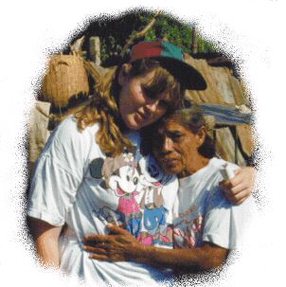 as any man. On many occasions a local villager would appear at the worksite with a sick
or
disabled child, looking for financial help. We appeared to the barrio to be rich.
Our barrio family of 13 was headed by Juana, a very strong lady of 47 years
who looked to
be in her late sixties. Her daughter Maria was the only other adult in the house that was
also occupied by 11 children. It is quite normal for there
to be no male figure. As the
days went by strong friendships were made between the barrio family, their friends that
came to help build and the Canadian youth.
It was amazing how much Spanish we either
learnt or just understood. Our work day was 7.30 am to noon. Some enthusiasts did go back
and put in an afternoon of work,
but for most of us it was too hot. After completion of
the house was a celebration. A bus was rented and all of us drove to a local recreation
centre where we
played ball, swam and enjoyed an afternoon together.
as any man. On many occasions a local villager would appear at the worksite with a sick
or
disabled child, looking for financial help. We appeared to the barrio to be rich.
Our barrio family of 13 was headed by Juana, a very strong lady of 47 years
who looked to
be in her late sixties. Her daughter Maria was the only other adult in the house that was
also occupied by 11 children. It is quite normal for there
to be no male figure. As the
days went by strong friendships were made between the barrio family, their friends that
came to help build and the Canadian youth.
It was amazing how much Spanish we either
learnt or just understood. Our work day was 7.30 am to noon. Some enthusiasts did go back
and put in an afternoon of work,
but for most of us it was too hot. After completion of
the house was a celebration. A bus was rented and all of us drove to a local recreation
centre where we
played ball, swam and enjoyed an afternoon together.
There were so many situations of great interest that we encountered during our Nicaraguan
visit. I will try to cover some. Most of our afternoons were taken
up by visits to a
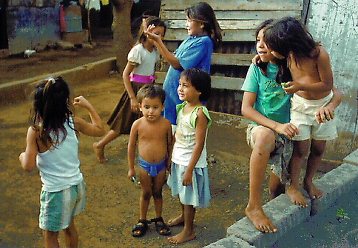 local place of interest. The state schools in Nicaragua are large enough
to house about
50% of the children at a cost of 5 cordoba a month, which equals approximately $1.00. For
every exam taken it also costs 5 cordoba. There is a national
school uniform of a white
shirt and navy blue trousers or skirt which is mandatory. Many families cannot start to
be able to afford these costs. Hence there is no
problem only housing 50% of the children.
Many children are sent out to work full time as early as age 5. They are often employed
selling on the street. They will
babysit one's car, or jump onto the hood of your car to
clean your windows in the hope of receiving a few coins. The city dump was full of children
picking up
garbage that could be resold. Organisations such as the Baptist church, the
Mennonite church and YMCA have initiated some programs for the children unable to attend
regular schooling. These programs enable the children to attend schooling when they are not working. Maybe a morning, afternoon or evening attendance. These programs
may also
include a meal, as many of these children arrive malnourished. Our weekends were spent
visiting 2 different beaches, at La Boquita and San Juan Del Sur -
both beautiful.
Good surfing was enjoyed by all. We visited the Masaya Volcano. a volcano still active,
the red lava eye clearly visible, the area totally unfenced.
I had nightmares of loosing
Rebecca over the top. Rebecca always busy with her camera, and always over-anxious to get
the best shot. We enjoyed an evening with the
young folk from the Atlantic coast who were
part of a mostly English speaking congregation of the First Baptist Church. We taught them
our 2 Spanish songs and
they joined with us and sang at their Sunday service. We enjoyed
another Sunday evening service of worship at Batahola Norte who have an extraordinary youth
choir
local place of interest. The state schools in Nicaragua are large enough
to house about
50% of the children at a cost of 5 cordoba a month, which equals approximately $1.00. For
every exam taken it also costs 5 cordoba. There is a national
school uniform of a white
shirt and navy blue trousers or skirt which is mandatory. Many families cannot start to
be able to afford these costs. Hence there is no
problem only housing 50% of the children.
Many children are sent out to work full time as early as age 5. They are often employed
selling on the street. They will
babysit one's car, or jump onto the hood of your car to
clean your windows in the hope of receiving a few coins. The city dump was full of children
picking up
garbage that could be resold. Organisations such as the Baptist church, the
Mennonite church and YMCA have initiated some programs for the children unable to attend
regular schooling. These programs enable the children to attend schooling when they are not working. Maybe a morning, afternoon or evening attendance. These programs
may also
include a meal, as many of these children arrive malnourished. Our weekends were spent
visiting 2 different beaches, at La Boquita and San Juan Del Sur -
both beautiful.
Good surfing was enjoyed by all. We visited the Masaya Volcano. a volcano still active,
the red lava eye clearly visible, the area totally unfenced.
I had nightmares of loosing
Rebecca over the top. Rebecca always busy with her camera, and always over-anxious to get
the best shot. We enjoyed an evening with the
young folk from the Atlantic coast who were
part of a mostly English speaking congregation of the First Baptist Church. We taught them
our 2 Spanish songs and
they joined with us and sang at their Sunday service. We enjoyed
another Sunday evening service of worship at Batahola Norte who have an extraordinary youth
choir
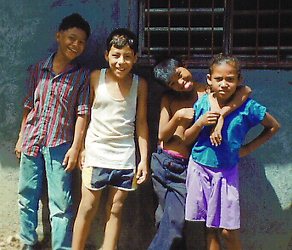 and orchestra. The entire congregation were to pray for the Canadian
visitors. We
were joined on different evenings by speakers who led our devotionals. They were also to
educate us on the revolution and uprisings of the 1980s'
and the tremendous earthquake of
1972. Our visit to the Life Centre for Women and Children in Ciudad Sandino, a project of
the Mennonite church, was a day to
remember. Here we were
able to speak, through an interpreter to the young people and women helped by the centre.
They were proud to
speak about their lives and
afterwards we all enjoyed a game of ball together. We spent
an evening at the national theatre, where we were treated to an evening of Nicaraguan
folklore music.
We were joined for 6 days by Ray and Leda Thompson. The Thompsons
worked with us daily. They are from Ottawa where Ray sang in the choir at Parkwood
for 20 years.
They now reside in Costa Rica.
and orchestra. The entire congregation were to pray for the Canadian
visitors. We
were joined on different evenings by speakers who led our devotionals. They were also to
educate us on the revolution and uprisings of the 1980s'
and the tremendous earthquake of
1972. Our visit to the Life Centre for Women and Children in Ciudad Sandino, a project of
the Mennonite church, was a day to
remember. Here we were
able to speak, through an interpreter to the young people and women helped by the centre.
They were proud to
speak about their lives and
afterwards we all enjoyed a game of ball together. We spent
an evening at the national theatre, where we were treated to an evening of Nicaraguan
folklore music.
We were joined for 6 days by Ray and Leda Thompson. The Thompsons
worked with us daily. They are from Ottawa where Ray sang in the choir at Parkwood
for 20 years.
They now reside in Costa Rica.
 March 18 arrived way too soon. Some people were up all night. There were so many mixed
feelings of returning home yet leaving our new-found friends. A dedication service was held for
our newly finished house, aptly named by the youth "Casa Por La
Esperanza", -- "House Built
With Hope". Many sad fairwells from Barrio Jorge Dimitrov and many promises that we would
be back.
March 18 arrived way too soon. Some people were up all night. There were so many mixed
feelings of returning home yet leaving our new-found friends. A dedication service was held for
our newly finished house, aptly named by the youth "Casa Por La
Esperanza", -- "House Built
With Hope". Many sad fairwells from Barrio Jorge Dimitrov and many promises that we would
be back.
I do believe that this trip was far more than building a house. It brought hope to a
village of people who had known few kindnesses. I believe they felt that
these young
Canadians had shown great caring and compassion but most of all friendship, giving them
a true feeling of worth. For the young Canadians this has been
a wonderful learning
experience and one that will be with them always. It will influence their lives as they
will influence the lives of others through their
experience of Nicaragua'96.
Gerry Hogan (Group Leader).
Letter from Central America
, Autumn 1996
Wouldn't it make more sense... ? -- John Duff
The adults being asked to support a youth work experience in Central America asked a
pertinent question: 'If what you want to do is help a poor family in Nicaragua
build a
new house, wouldn’t it make more sense just to send them the money?" After all it was
reasoned, materials for the house could be had for $1,500, while
sending the Canadian
group down there to help build it would cost ten times that much. If the bottom line is
building houses, it would indeed be more efficient
to just send the money. The question
challenged the youth to think again about why they wanted to go. Their first stab at a
statement of purpose talked about going
to build something for people in need in Nicaragua.
After talking about it some more, they decided they were going to work beside Nicaraguans to
build friendships
and to learn about life in a different culture.
Putting flesh on that purpose, during two unforgettable weeks in March, involved getting
to know and love the members of the family whose flimsy shack came
down in just a couple of
hours, and whose new house went up with their own efforts, and that of their neighbors,
joined with that of their Canadian friends. It
included exchanging experiences with young
people in a church project in Ciudad Sandino, listening to their songs, and playing some
ball in the street with them.
There was the day that some Nicaraguan young men in El Cacao,
related to the YMCA (and encouraged in their musical talents by the visit of Laura Stevenson
last year),
sang moving songs they had written about their ideals of caring, equality and
mutual respect in the relations between men and women - astonishing words in a culture
with
so much 'machismo’. There was the day when they went to the city dump, and saw children,
women, and men picking through garbage for plastic, metal and paper
that
could be sold for recycling to give them a meagre subsistence, and then realized how much
it meant that some of those children had the opportunity to be part of
a folk-dancing group,
and to imagine a world of beauty and grace. There were times for play with children in the
barrio, for smiles and hugs that need no words to
create understanding. There was a Saturday
night exchanging songs and dances with youth rooted in the Carribean culture of the Atlantic
coast, and a Sunday morning
singing hymns and anthems together with them in church.
There were difficult moments along the way, too. After visiting the garbage dump some came
back to their hostel to turn the radio up loud in the bathroom and
take long, long showers.
After meeting the family in the barrio for whom we were building a house some wanted to sell
all that they had and work 36 hours a day if
possible, to do as much as they could in their
short time to make a difference for their new friends - and couldn't appreciate that others
still wanted to spend
an afternoon at the beach. We had to work at learning tolerance of
the different ways people in the group lived their culture and poverty shock. But in the
end,
by the grace of God, we found reconciliation and reached for understanding.
The presence of the Canadian young people was an encouragement for the Nicaraguans to whom
they came, in a way that a cheque in the mail could not have been.
Afterwards the Canadian
young people said that the experience had been life-changing for them. For some, it deepened
Christian faith. Others felt confirmed in a
calling to overseas service. After meeting
people more fully alive and deeply spiritual than many Canadians, with fewer material
things in their hands, there have
been changes, too, in the way participants now perceive
our own culture and consumer lifestyle.
Did the trip make sense? Only if you think differently about where the bottom line really
is. And thinking differently about the bottom line might be healthy
for us, not just when
it comes to sending youth delegations to Central America, but for much else that we do in
the church, and in our society.

the preferred method of transportation:
the limo, with our chauffeur, Guadeloupe ("Juan" Duff in foreground)
